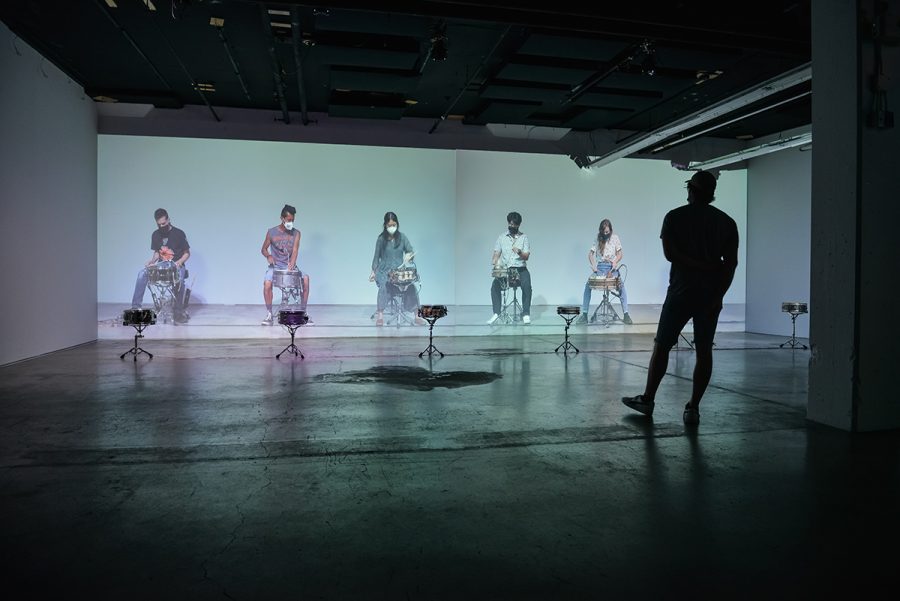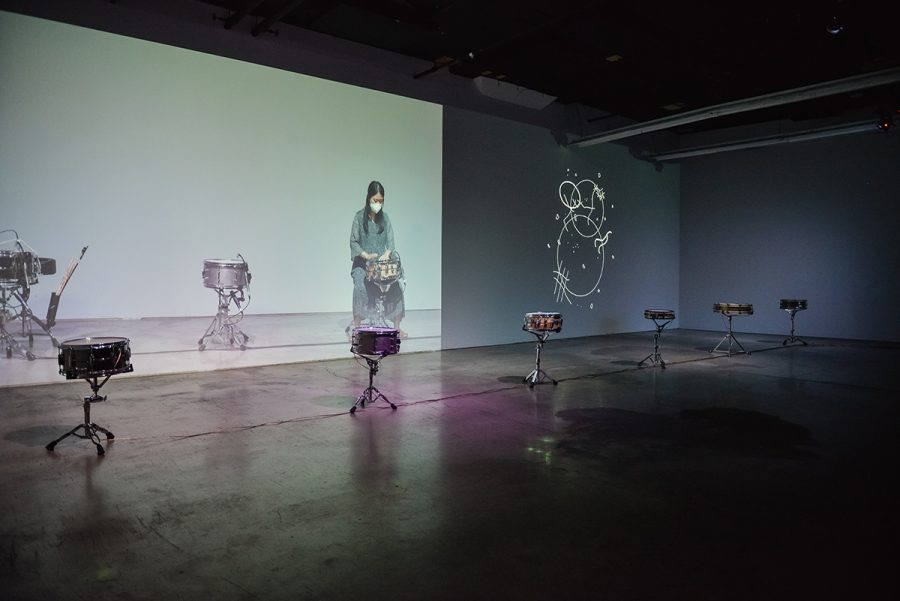On day three of an unprecedented heat wave hitting the west coast of North America, I walked into the exhibition, Rudiments for Hexadrome by Vancouver-based artist John Brennan. The midday heat had seeped into my skin and I brought it into the gallery space, like a ghost beside me. The dark, cool gallery space presented six snare drums, each with a transducer inside resonating the rhythms recorded by collaborators Adrian Avendaño, César Chew, Mili Hong, Jamie Lee, and Jennifer Yakamovich backdropped by a visual screening of their performance.
When Mili Hong plays her Solo #1, she places skin on drum, palms, fingertips, and wrists in the place of mallets and sticks. When Mili flicks her nail beds on the snare, I dream of drops of rain. It is a prodding rhythm, a gentle trickle. She rubs her palms against the snare in circles, a soft friction that makes the sound of sand moving across a hard surface. When she closes her fist and taps knuckles to snare, it makes the sound of bone-on-drum, reminding the listener of the hardness of our interiority. She then moves her hand to tap the outer snare, the drum’s metal exoskeleton of bolts and screws. Moving her hands from the outside of the snare to the surface, Mili is shifting her own body from softness to hardness, blurring the edges between exterior and interior into sounds that slip and spill.

When I think of the word “snare,” I think of a hunting trap. How, when a creature enters a loop of wire, the snare slips, transforming a circle into a noose. To successfully catch a creature with a snare, the hunter depends on a rhythm of pattern: the predictable footfall of the creature’s path. When César Chew plays his Solo #6, he is unpredictable: rattling two shakers across the snare and dancing his fingertips, making the sound of a creature rustling. He then taps the pointed ends of the shakers on the snare, bouncing the rhythm like feet bounding off of the earth. César’s own feet dance too—his black Converse sliding out from his body as he lifts from his seat— sound and gesture embodied. Moving the shakers off the snare, he dances them in the space all around it, at his side and behind his back—the darting of a sound that cannot be trapped.
Excerpt of Untune by John Brennan. Courtesy of the artist.
Improvisation with others is as much about the space between sounds as it is about the sounds themselves. Like a conversation, space creates the back and forth of a discourse. Group Score #2 by Jamie Lee begins with a marching beat, a syncopation that builds before splitting into layers. The players, with their mallets and masks, do not look at each other but instead converse with their bodies. Slight gestures ripple down the line with the passing of the beat—the nod of a head, the switching of a mallet end. For many sounds to play at once, while remaining both independent and cohesive, sounds must move around each other. One single rhythm cannot drown out all registers. This spatial balance gives the score a tightness despite the free-flowing nature of the instrumentals.
When John Brennan plays Solo #3, he begins with palms on snare and slowly elicits an eerie wane of feedback from the modified snare, using a homemade contact microphone and a transducer. Brennan’s hands intervene in the negative space between the two receptors, producing a sound that feels vibratory in a technological sense, and respiratory in a bodily sense. Pushing his fingers into the snare, he gently bounces the beat in sonic waves that ebb against the physical field of his body. It gives an enigmatic ring that is both coming and going at once. When the sound ripples to a crescendo, Brennan quells it by fluttering his palms before laying them flat, resting the loop to end where he began.

Brennan’s exploration of the loop is symbolic of the broader processes in Rudiments for Hexadrome. The collaborative sound-making for this project occurred predominantly online. The translation of sound from each player’s lived environment to their shared virtual realm is a loop that recurs in the final installation, where sound and gesture are relayed to the listener in the gallery through screen and speaker. These processes of looping, exchange, and translation are palpable across the final scores where sonic interactions are explored in rhizomatic and non-linear ways. At the root of it all is an installation that considers how to keep a beat—to hold it, explore it, and pass it on. Beyond its musical implications, the artwork made me consider what this means in the networks of our everyday lives. I thought about other people walking around the hot city that day—all of us like little snares, carrying the beat of the sun into the spaces in which we move. What beat do we create through the noise of our actions, what rhythms do we pass on? What loops do we rupture and what patterns do we return to? Outside of the gallery, I re-enter the afternoon heat wave and listen to a score of stale air, dried grass, and wilted trees.
Excerpt of never ending commute by Adrian Avendano. Courtesy of John Brennan.
Rudiments for Hexadrome by John Brennan showed at VIVO Media Arts Centre in Vancouver, BC in 2021.

